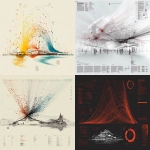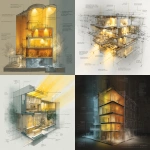Explore the Best AI Image Gallery

Beyond Reality: How VR and AR are Transforming the Gaming Industry
The gaming industry is a dynamic landscape constantly evolving with new technologies. Among the most transformative advancements are virtual reality (VR) and augmented reality (AR), which are reshaping how we play, interact, and experience games. These immersive technologies are not merely adding bells and whistles to existing titles; they are fundamentally altering the very core of gaming, creating experiences that blur the lines between the virtual and real worlds.
A New Dimension of Gameplay
VR transports players into entirely digital environments, allowing them to step inside the game world and interact with it in a physical way. Using headsets that track head movements and body position, players can look around, move about, and perform actions within the virtual space. This sense of presence creates a level of immersion previously unattainable in traditional gaming, fostering a deeper connection with the narrative, characters, and environment.
AR, on the other hand, overlays digital elements onto the real world through devices like smartphones or smart glasses. Players can interact with virtual objects and characters superimposed on their surroundings, blending the physical and digital realms in unique ways. AR games often encourage exploration and social interaction as players engage with virtual content in shared spaces.
Impact on Game Development
The advent of VR and AR has presented game developers with exciting new possibilities.
Immersive Storytelling
VRs ability to place players within a narrative allows for more compelling and emotionally resonant storytelling. Developers can create truly immersive experiences that allow players to feel like they are part of the story, making decisions that directly impact the outcome.
Enhanced Gameplay Mechanics
VR and AR open up new avenues for gameplay mechanics. For instance, physical actions in VR translate directly into game actions, creating a more intuitive and engaging experience. AR games can utilize real-world locations as part of the gameplay, encouraging exploration and interaction with the environment.
New Creative Tools
VR and AR development tools are constantly evolving, providing developers with increasingly sophisticated ways to create immersive experiences. These tools empower creators to build worlds, design interactions, and tell stories in ways that were previously unimaginable.
Ethical Considerations
As VR and AR become more prevalent in gaming, it is crucial to address the ethical implications of these technologies.
Virtual Reality Sickness
One concern is motion sickness, which can occur when there is a mismatch between visual input and physical sensation in VR. Developers need to prioritize user comfort by designing experiences that minimize nausea and dizziness.
\nData Privacy
VR and AR often collect a significant amount of user data, including location, movement patterns, and even biometric information. It is essential to ensure that this data is collected and used responsibly, with transparency and user consent.
Social Impact
Immersive technologies can have a profound impact on social interactions. Its important to consider the potential for addiction, isolation, and the blurring of lines between online and offline realities.
Future Trends
The future of VR and AR in gaming is brimming with possibilities.
Standalone VR Headsets
Advancements in technology are leading to more powerful and affordable standalone VR headsets, eliminating the need for tethered connections to computers. This will make VR more accessible and convenient for a wider range of users.
Cloud Gaming and Streaming
Cloud gaming services will enable players to stream high-quality VR and AR experiences without requiring powerful hardware. This will further democratize access to these immersive technologies.
Haptic Feedback and Sensory Immersion
The integration of haptic feedback and other sensory elements will enhance the sense of immersion in VR and AR games. Imagine feeling the texture of a virtual object or the wind on your skin as you explore a digital world.
Metaverse Convergence
The concept of the metaverse, a persistent interconnected network of virtual worlds, is gaining traction. VR and AR will likely play a central role in shaping these immersive virtual environments.
Conclusion
VR and AR are revolutionizing the gaming industry, creating immersive experiences that redefine how we play and interact with games. As technology continues to advance, we can expect even more innovative applications of these technologies, blurring the lines between reality and virtuality further.
The future of gaming is undeniably immersive, and VR and AR are at the forefront of this exciting evolution.










](https://images.ai-img.art/thumbnails/150/9bfac23b6df1e372ace320fda84e18e5e2e668451feacef8c46af60a9f444ad6.webp)

](https://images.ai-img.art/thumbnails/150/93f6b867d7e0d1ef5b08c9115efd6d3cbcc0fcfe07dc47e55d9b3a50056a189e.webp)













](https://images.ai-img.art/thumbnails/150/469c20665b824a8c49e8b66856a2f9843e7a36c40760ace1e7fd5f2125a32e25.webp)






















](https://images.ai-img.art/thumbnails/150/3521ea1bce510dbac19d74a3e037e7179b754ae98e8a44c08863e51468c18caa.webp)